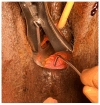The Role of Graciloplasty in the Treatment of Obstetric Anal Sphincter Injury with Subsequent Fecal Incontinence and Recurrent Low Recto-Vaginal Fistula: A Case Report
- PMID: 40729224
- PMCID: PMC12199946
- DOI: 10.3390/reports8010011
The Role of Graciloplasty in the Treatment of Obstetric Anal Sphincter Injury with Subsequent Fecal Incontinence and Recurrent Low Recto-Vaginal Fistula: A Case Report
Abstract
Background and Clinical Significance: Recto-vaginal fistulae (RVF) and fecal incontinence (FI) pose significant challenges for colorectal surgeons. Various therapeutic options have been proposed for each condition over time. Despite its procedural complexity and the risk of complications, graciloplasty remains a viable therapeutic option for both conditions, with favorable long-term results. To our knowledge, this is the first report of a case where the need to treat both conditions concurrently arose. Case Presentation: We report the case of a 54-year-old woman with severe FI and repeatedly operated on recurrent recto-vaginal fistula. The patient underwent graciloplasty to provide healthy tissue with an adequate vascular supply to both enhance the healing process of the fistula and reshape the anal canal with a circular muscular structure. Following the procedure, the patient experienced prompt symptom resolution and good clinical and functional recovery at a 1-year follow-up evaluation. Conclusions: This case report highlights the safety and effectiveness of an overlooked procedure for the treatment of large sphincter defects and concurrent recto-vaginal or recto-vaginal tears.
Keywords: ano-vaginal fistula; case report; fecal incontinence; graciloplasty; obstetric anal sphincter injury; recto-vaginal fistula.
Conflict of interest statement
The authors declare no conflicts of interest.
Figures




Similar articles
-
Use of endoanal ultrasound for reducing the risk of complications related to anal sphincter injury after vaginal birth.Cochrane Database Syst Rev. 2015 Oct 29;2015(10):CD010826. doi: 10.1002/14651858.CD010826.pub2. Cochrane Database Syst Rev. 2015. PMID: 26513224 Free PMC article.
-
Anal incontinence following obstetric anal sphincter injury: Is there a difference between subtypes? A systematic review.Neurourol Urodyn. 2023 Sep;42(7):1455-1469. doi: 10.1002/nau.25235. Epub 2023 Jul 10. Neurourol Urodyn. 2023. PMID: 37431160
-
Counseling women with obstetric anal sphincter injury - Risk of recurrence and the influence of mode of second delivery on subsequent anal incontinence - A systematic review and meta-analysis.Eur J Obstet Gynecol Reprod Biol. 2025 May;309:14-22. doi: 10.1016/j.ejogrb.2025.03.018. Epub 2025 Mar 11. Eur J Obstet Gynecol Reprod Biol. 2025. PMID: 40090037
-
Predicting obstetric anal sphincter injury in the first and second vaginal delivery and after a cesarean delivery: development and validation of an intrapartal model.J Clin Epidemiol. 2025 Jul;183:111782. doi: 10.1016/j.jclinepi.2025.111782. Epub 2025 Apr 10. J Clin Epidemiol. 2025. PMID: 40216339
-
Short- and long-term outcomes of sphincteroplasty for anal incontinence related to obstetric injury: a systematic review.Updates Surg. 2023 Sep;75(6):1423-1430. doi: 10.1007/s13304-023-01609-1. Epub 2023 Jul 29. Updates Surg. 2023. PMID: 37516713
References
-
- Bordeianou L.G., Thorsen A.J., Keller D.S., Hawkins A.T., Messick C., Oliveira L., Feingold D.L., Lightner A.L., Paquette I.M. The American Society of Colon and Rectal Surgeons Clinical Practice Guidelines for the Management of Fecal Incontinence. Dis. Colon Rectum. 2023;66:647–661. doi: 10.1097/DCR.0000000000002776. - DOI - PubMed
-
- Yoshioka K., Hata Y., Iwamoto S., Nakane Y. Treatment of Anorectal Functional Disorder-Focused on Graciloplasty. Nippon Daicho Komonbyo Gakkai Zasshi. 2007;60:906–910. doi: 10.3862/jcoloproctology.60.906. - DOI
Publication types
LinkOut - more resources
Full Text Sources
